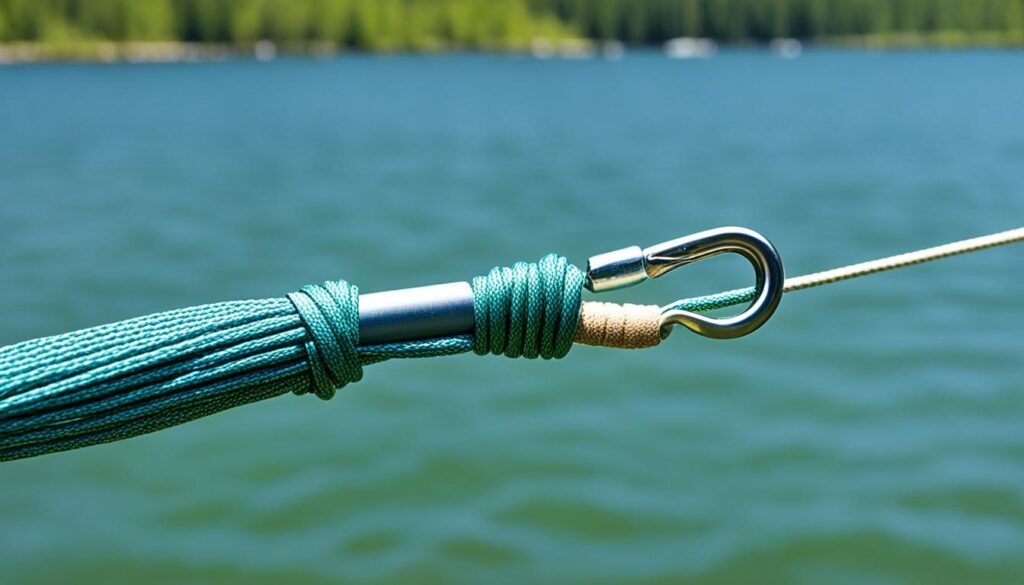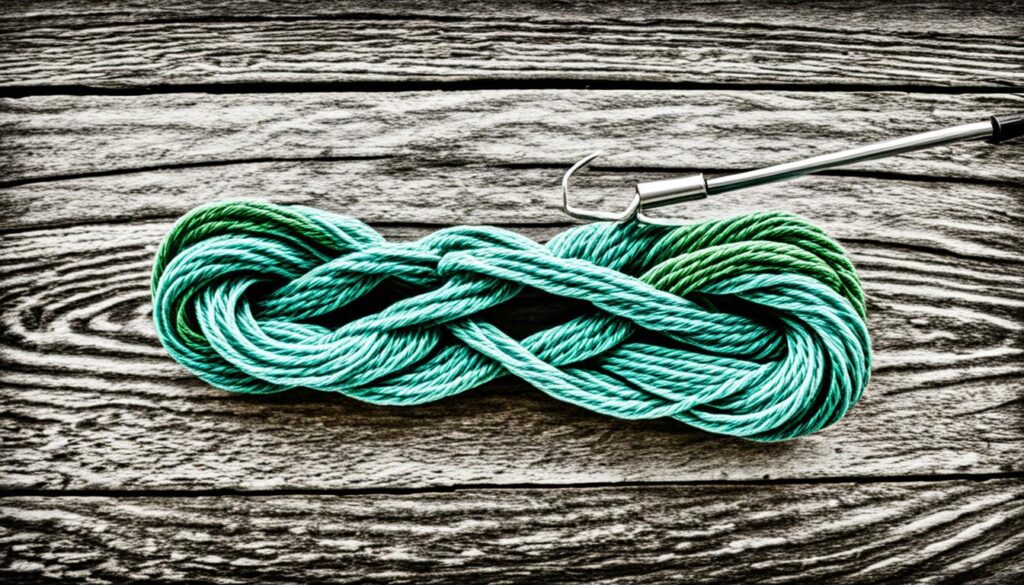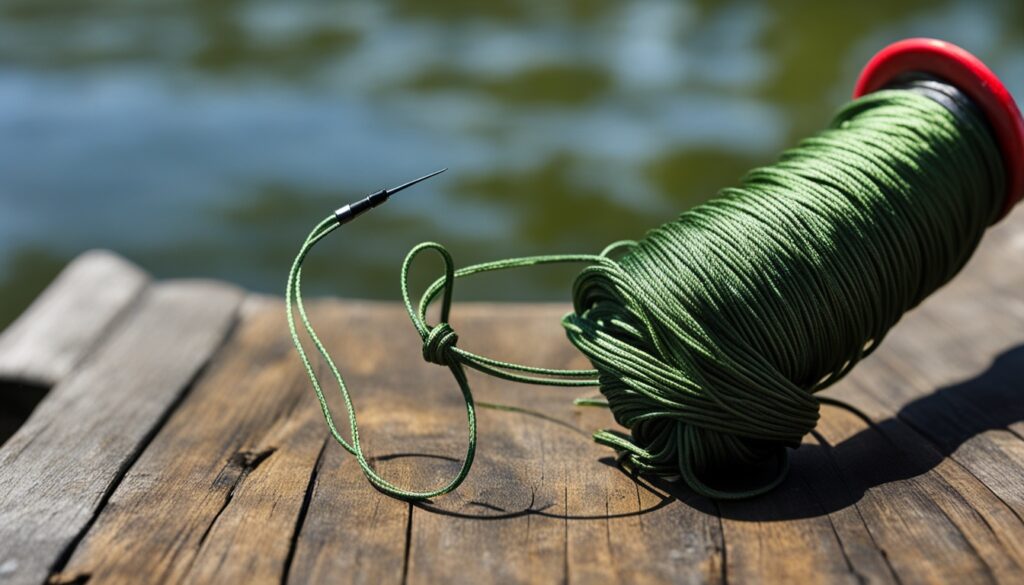Mastering how to tie a non slip loop knot can significantly enhance your experience if you’re passionate about fishing. This straightforward and robust knot is ideal for securely attaching hooks, lures, and swivels to your line, boosting your chances when a big fish strikes.
Its main advantages include the ability to easily change fishing gear, allowing for a more natural movement of lures and hooks, making them more enticing to fish. Effective in ocean and river fishing, learning this knot well will increase your catches and make fishing more enjoyable and rewarding.
The Non Slip Loop Knot
The non-slip mono loop knot is loved by fishermen. It’s easy to make and great for hooks, lures, and more. Made for monofilament lines, it stays strong in any fishing spot.
Tying the Non-Slip Mono Loop
Here’s how to do the non-slip mono loop knot:
- Put the line’s end through your hook or lure’s eye.
- Bring the line’s end back and form a small loop with it.
- Wrap the line end 5-7 times around the line. Make sure the wraps are neat.
- Put the line end through the small loop you made earlier.
- Get the knot wet with water or saliva. Then, pull it tight firmly. This makes sure your hook, lure, or other tackle won’t slip off.
Advantages of the Non-Slip Mono Loop
The non-slip mono loop knot has many good points for anglers:
- Strength and Reliability: It can handle big fish in tough fights. It’s a favorite in the sea and at the lake.
- Ease of Tying: The non-slip mono loop knot is easy to learn. This lets anglers get back to fishing sooner.
- Versatility: It’s great for hooks, lures, and swivels. Perfect for all kinds of fishing.
- Smooth Operation: This knot allows your gear to move freely. It makes bait look natural and lures work better.
non slip loop knot for fishing
The non-slip loop knot is essential for saltwater and freshwater fishing, providing a reliable and robust connection between the fishing line and components like hooks and swivels. This knot is celebrated for several reasons:
- It creates a sturdy loop that facilitates the addition of hooks and tackles.
- The knot maintains a neat, twist-free connection.
- It holds firmly without slipping, even when under significant tension.
- It’s straightforward to learn, making it accessible to anglers of all skill levels.
Ideal for targeting big, powerful sea fish, the non-slip loop knot ensures that your gear remains secure, enhancing your chances of a successful catch. This knot is also invaluable in freshwater environments, where it confidently attaches your line to lures or hooks. Mastering this knot is a valuable skill for any angler, increasing the enjoyment and success of your fishing adventures.

Perfection Loop Knot
The Perfection Loop Knot is famous for fishing. It creates a durable loop at the line’s end, allowing anglers to easily connect leaders and other lines.
Tying the Perfection Loop
Steps to tie this knot are simple:
- Put the tag end through the fishing hook or lure’s eye.
- Wrap the tag end around the standing line 5-7 times, close together.
- Put the tag end through the nearest loop and then the bigger loop.
- Wet the knot and pull the standing line and tag end to secure tightly.
- Cut off the extra tag end to leave a small tag.

Surgeon’s Loop Knot
The Surgeon’s Loop Knot is a handy loop knot for both saltwater and freshwater fishing. It connects hooks, lures, or flies to your line. This knot is perfect for quick tackle changes. It can also make dropper loops to add more flies to your line.
Steps to Tie the Surgeon’s Loop
Here’s how you tie the Surgeon’s Loop Knot:
- Start by making a small loop at the end of your line.
- Pass the tag end through the loop from the back to the front.
- Wrap the tag end around the main line 4-5 times, then through the loop again.
- Wet the knot and pull the tag end to tighten the loop knot.
- Cut off the extra tag end so you have a neat finish.
The Surgeon’s Loop Knot is strong and doesn’t come loose easily. It’s really useful for a lot of fishing needs. You can attach lures or flies. You can also use it for making loop knot instructions for putting more flies on your line.

Spider Hitch Knot
The Spider Hitch Knot helps make a leader or a double line. It creates a strong loop at the line’s end. This knot is critical for offshore and big game fishing because it needs to be strong for big fish.
Creating a Double Line with the Spider Hitch
To make a double line with the Spider Hitch Knot, start by folding your fishing line in half. This makes a loop. Then, tie the Spider Hitch Knot around this loop. It’s great for adding a shock leader or tackle because it’s strong.
Uses of the Spider Hitch
The Spider Hitch Knot is handy in fishing for more than just double lines. Some other uses are:
| Application | Benefit |
|---|---|
| Attach a shock leader | The Spider Hitch makes your line stronger for adding a shock leader. |
| Secure a loop knot | It makes a dependable loop at your line’s end. This makes it easy to add hooks or lures. |
| Improve casting distance | The Spider Hitch helps cast better by reducing line wear and tear. |
Improved Clinch Knot
The Improved Clinch Knot is a top choice among basic fishing knots. It’s great for fastening your fishing line to a hook or lure and works well with different lines, such as monofilament and fluorocarbon, for various fishing needs.
To tie an Improved Clinch Knot, pass the line’s end through the hook’s eye. Make 5-7 tight turns around the main line. Then, pass the line end through the first loop, followed by the larger loop, and pull it snugly.
This knot is easy and strong, making it popular with anglers of any level. It ensures a sturdy link between your fishing line and the hook or lure. So, it’s a reliable choice whether you’re after a big catch or just fishing for fun.
Palomar Knot
The Palomar Knot is a well-known fishing knot for its trustworthiness. It can be used with braided and monofilament lines. It’s a top choice because it’s easy to do and performs well every time.
Tying the Reliable Palomar Knot
Here’s how to tie the Palomar Knot:
- Thread the end of your line through the eye of the hook or lure.
- Double the line back, forming a loop.
- Pass the tag end of the line through the loop.
- Holding the loop, pass the tag end through the loop again.
- Moisten the knot and tighten it down firmly against the hook or lure.
Snell Knot
The Snell Knot is a favorite among anglers. It links hooks to fishing lines well, allowing for strong hook sets when catching fish. It’s used in bait fishing and fly fishing.
Attaching Hooks with the Snell Knot
Here’s how to tie the Snell Knot:
- Thread the fishing line end through the hook’s eye.
- Wrap the line 5-7 times around the hook’s shank. Keep these wraps tight together.
- Feed the line’s end back through the hook’s eye from the opposite side.
- Get the knot wet with water or saliva. Then, pull the line tight to secure the Snell Knot.
- Cut off any extra line. Leave a short part as a tag end.
Albright Knot
The Albright Knot is excellent for joining fishing lines of different sizes. It’s perfect for when you need to switch between your main line and a leader. This knot keeps your connection strong and reliable.
Connecting Lines of Different Diameters
The Albright Knot is special because it works with lines of different sizes. It’s ideal for moving from a thick main line to a thin leader or vice versa. This knot keeps a sturdy bond without weakening your setup.
Learning the Albright Knot helps anglers improve their equipment and fishing results. With some practice, tying this knot becomes quick and easy. You’ll feel confident that your lines are firmly connected for your next fishing trip.
FAQ
What is the non-slip loop knot and how is it used in fishing?
The non-slip loop knot is both versatile and secure. It creates a loop at the end of the fishing line. Then, you can easily attach hooks, lures, or swivels. It’s excellent for use in saltwater because it stays strong.
What is the non-slip mono loop knot and how do you tie it?
The non-slip mono loop knot is great for fishing. It’s easy to tie and makes a safe connection for hooks and lures. Here’s how to tie it: [insert step-by-step instructions].
How is the non-slip loop knot used in fishing?
The non-slip loop knot is vital for fishing, especially in saltwater. It makes a strong link between the line and tools like hooks. It is very reliable for use in different fishing gear.
What is the Perfection Loop Knot and how do you tie it?
The Perfection Loop Knot is a strong loop knot. It’s great for connecting different lines, like leaders. Here’s how to tie it: [insert step-by-step instructions].
What is the Surgeon’s Loop Knot and how is it used in fishing?
The Surgeon’s Loop Knot is useful for adding hooks or flies. It’s good for changing tackle quickly. It can also help set up multi-fly systems. To tie it, follow these steps: [insert step-by-step instructions].
What is the Spider Hitch Knot and how is it used in fishing?
The Spider Hitch Knot makes a strong leader or double line. It’s often used in offshore fishing for its strength. To make a double line, follow these steps: [insert step-by-step instructions]. The Spider Hitch Knot is useful in many fishing situations.
What is the Improved Clinch Knot and how is it used in fishing?
The Improved Clinch Knot is a simple and popular knot. It secures the line to a hook well. It’s great for different types of hooks and lures.
What is the Palomar Knot and how do you tie it?
The Palomar Knot is known for being very strong. It’s good for braided and monofilament lines. To tie it, follow these steps: [insert step-by-step instructions].
What is the Snell Knot and how is it used in fishing?
The Snell Knot is for attaching hooks for a direct pull. It’s great for getting a solid hook set. It’s used in bait and fly fishing. To tie it, follow these steps: [insert step-by-step instructions].
What is the Albright Knot and how is it used in fishing?
The Albright Knot connects lines of different sizes, like mono to fluorocarbon. It makes a strong link for various fishing needs. To tie the Albright Knot in this way, follow these steps: [insert step-by-step instructions].
